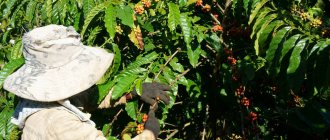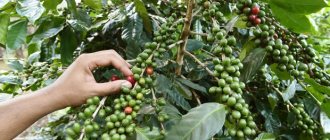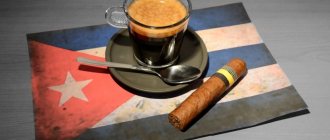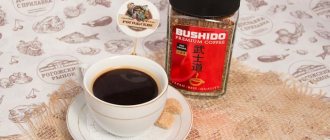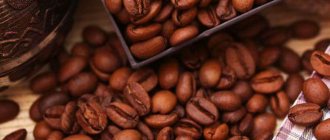How do you start your day? A real life hacker will answer - from a run and a shower. Skeptics will laugh it off - from the toilet.
The Lifehacker Telegram channel contains only the best texts about technology, relationships, sports, cinema, finance and much more. Subscribe!
Our Pinterest contains only the best texts about relationships, sports, cinema, health and much more. Subscribe!
But for most, morning is coffee, and coffee is morning. However, getting into a working mood and enjoying aromatic espresso, hardly anyone thinks that coffee is one of the most popular drinks in the world.
About 760 billion cups are consumed annually. At the same time, Scandinavians drink the most coffee - almost 12 kg per year per capita; Italians and Brazilians are a little behind – 4-5 kg. Russians (even here!) are at the end of the list - only half a kilo per person.
With such popularity, it is not surprising that each state has its own coffee secrets. I suggest you go on an exciting journey and learn 5 aromatic coffee recipes from different countries of the world.
Finland: coffee with cheese
Coffee with cheese - original! A special type of cheese is poured with hot coffee, after which the drink must infuse a little. After drinking coffee, the cheese is eaten with a spoon. Experts prepare coffee cheese (Kaffeost) themselves, but we suggest you take your favorite soft cheese.
- cup of brewed black coffee
- sugar to taste
- a couple of pieces of soft cheese
Place soft cheese cubes in a cup and pour hot coffee over it. Add sugar as desired and mix gently. Drink coffee and eat cheese.
Brazil
If you are a true coffee connoisseur, then you know for sure: Brazil is a coffee country. Almost a third of all grain grown in the world belongs to this state. But not only in terms of yield and volumes of coffee exports, Brazilians are ahead of other countries. Temperamental South Americans also occupy a leading position in the consumption of this wonderful drink. They drink it for breakfast, after lunch and dinner, as well as instead of and in between. Tea is chosen only on special occasions. The most popular coffee drink in Brazil is called cafezinho, which translates to “little coffee.” It’s not enough because they only pour half a glass of it, although you can add a little more water or milk if you wish. But it will be a different drink. Sometimes “cafezinho” is served in small cups. Brazil's national coffee is filtered using a cloth or paper strainer and served hot and very sweet.
Mexico
The favorite drink of Mexicans is Cafe de Olla. He has several secrets. Firstly, this coffee is brewed over very low heat. Secondly, during the cooking process, a cinnamon stick is dipped into the boiling liquid for aroma and taste. Thirdly, the drink is sweetened with cane sugar, which gives the bouquet caramel notes. And, fourthly, they pour coffee into clay cups - Mexicans believe that only natural material can reveal the fullness of the taste.
Vietnam: coffee with egg
You can easily replace dessert with Vietnamese coffee, as it tastes like the favorite dessert of many, tiramisu. This coffee is prepared from egg yolk, condensed milk and hot Vietnamese coffee.
- egg yolk
- 3 tbsp. l. Vietnamese coffee powder
- 2 tsp. condensed milk
- boiling water
Brew a small cup of Vietnamese coffee. Separate the white from the yolk. We don't need the protein, use it to prepare other dishes. Whisk the yolk with condensed milk into a thick foam, add a couple of spoons of coffee to the mixture and stir. Pour the brewed coffee into a large cup and place the egg mixture on top.
Portugal
The Portuguese can perhaps compete with the Brazilians in the amount of coffee consumed per day. In this country, they also love coffee and drink it in abundance - in liters, at any time and in any place. 5-6 cups a day, or even more. Espresso is especially held in high esteem by locals. To brighten up the drink, many Portuguese prefer to add lemon juice or lemon-flavored soda. Even if you just imagine it, it’s quite an “explosive” elixir. By the way, in Italy the classic coffee drink is espresso with a slice of lemon. There is something in this, you need to try it.
Greece: Frappe coffee
Frappe is a cold drink made from coffee, ice cream, milk and ice cubes.
- 2 tsp. instant coffee
- 2 tsp. Sahara
- 2 tbsp. l. milk
- ice
- cold water
Coffee, sugar and 2 tbsp. l. Beat with cold water in a shaker or mixer until foamy. Place a few pieces of ice in a glass, add foam and fill with cold water. If desired, add milk.
Mexico: sweet coffee in a jug
Authentic Mexican coffee is filtered through a paper filter into a clay jug with the addition of cinnamon and unrefined brown sugar. This coffee is considered one of the “cleanest”, as it is brewed exclusively from natural, unprocessed products. The only thing to be wary of is the amount of sugar in the cup, but you can adjust this to your taste.
- 2 glasses of water
- 5 tbsp. l. brown sugar
- 2 cinnamon sticks
- 2 clove buds
- pinch of anise seeds
- 3 tbsp. l. black coffee
Place water and spices in a saucepan and bring to a boil. Cook for five minutes over medium-high heat. Remove the saucepan from the heat and add coffee. Cover with a lid and let sit for five minutes. Strain and serve immediately. It's great to add whipped cream on top.
Types of coffee (drink)
Coffee with milk
Coffee with milk is prepared using black coffee and preheated milk. The drink can be prepared using either espresso or Americano.
In European countries, coffee with milk is known under different names: “café con leche” in Spain, “kawa biała” (from Polish - “white coffee”) in Poland, “Milchkaffee” (from German - “milk coffee”) in Germany, “koffie verkeerd” (from the Dutch - “wrong coffee”) in the Netherlands. In Northern Europe and North America, the most common French name for the drink is “café au lait.”
In most cases, coffee with milk is served in a cup, in the “French style” - in a white ceramic cup.
Espresso
Espresso is a black, strong coffee made from dark roasted coffee varieties. This is a strong and rich drink with a thick, creamy foam that contains no additional ingredients other than coffee and water.
Ingredients: coffee – 7g, water – 35 ml. Usually prepared in a coffee machine.
Consumed hot, practically in one gulp.
Expresso coffee is served in small (50-60 ml), always warmed cups with thick walls. In them, the coffee does not cool down so quickly.
Espresso Variations
Lungo : a coffee drink prepared using a coffee machine similar to espresso, but with more water - 50-60 ml.
Doppio : double dose of espresso.
To prepare 1 small cup of espresso coffee you will need: 7 g of ground coffee and 40-65 ml of fresh water. It is better to prepare express coffee in a coffee maker. Pay attention to the cooking method. Coffee will be especially aromatic if the beans are ground immediately before drinking. The finished coffee should have the thickness of cream and a head of foam on the surface. They say that the first portion of coffee, just like beer, is not the most delicious.
Americano
Americano : This is espresso diluted with water. To prepare, water is added to the finished espresso to a volume of 150-160 ml.
When American troops occupied Italy during World War II, local bars filled with officers demanding a “big cup of coffee” rather than a small Italian espresso. Especially for Americans, enterprising Italians began to dilute “espresso” with hot water, disparaging such an order - “Americano...”. And in the post-war period, already in the USA, coffee shops with espresso coffee makers installed in them accepted Americano into their assortment.
The first phase of preparing an Americano is completely identical to espresso, but after pouring a dose of espresso (30 milliliters), the bartender does not turn off the coffee maker, but continues to pass water until the volume reaches 120–150 milliliters.
Today the standard volume of Americano is 120-150 ml. This is the size of a cappuccino cup at a bar, and is what an Americano is served in.
In addition to the “Italian” option of diluting espresso with water (when the bartender does this), there is also the so-called “Swedish” option. In this case, the client is served a standard cup of coffee, a glass of boiling water and an empty cup - and he decides how much water he wants to add to dilute the drink.
Volume of a human sip Measurements have shown that a man consumes an average of 21 milliliters of liquid per sip, and a woman 14 milliliters. The volume of an espresso drink is 30 milliliters.
Filter coffee
Filter coffee is coffee prepared by pouring hot water once through a layer of ground coffee on the filter. Water is poured manually or using a drip coffee maker that automates the pouring process.
Many methods of brewing coffee use a filter, but what makes filter coffee different from all others is that the water infiltrates through the process using gravity alone.
For the last century, the mainstay of US coffee culture has been coffee prepared using so-called “drip coffee makers.” In these coffee makers, boiled water passes through a paper filter in which the coffee is placed and drops drop by drop into the cup. Hence the name “drip” in Russian or “filter coffee” in English. A drip coffee maker is inexpensive and easy to use, the drink is quickly prepared, and, most importantly, there is a lot of it, and it is usually served in large mugs with a volume of 200-220 ml, called “mug”. Filter coffee is often prepared in clear containers (called “decanters”).
The so-called dissolution theory states that “the amount of dissolved solids characterizes the degree of strength of the method of preparing a particular drink.” There are 1.4% of these “solids” in prepared filter coffee, and 0.8% in Americano. That is, during the process of preparing filter coffee (when the total mass of ground coffee is brewed with water), the drink turns out to be more uniform in taste and extraction. And espresso with water (in the case of Americano) is actually the result of ordinary mixing and is 2 times inferior to filter coffee in terms of the amount of dissolved solids (and, therefore, in the strength of the resulting drink - 0.8 versus 1.4).
Latte
Latte (an anglicized and shortened version of the Italian caffè latte - “coffee with milk”) is a coffee drink originally from Italy, consisting of espresso coffee and hot milk (Italian latte).
In Italy, latte is prepared at home and served for breakfast. The original Italian recipe called for using only Arabica. Now you can change the grains at your discretion. The top layer of a latte should, of course, be foam. Outside of Italy, a latte is usually made from a shot of espresso, which is topped with either hot or cold steamed milk.
Regular latte ingredients:
1 part espresso (usually 50 ml); 2 parts hot whipped milk (100 ml); 1 part milk foam (50 ml).
Latte is usually served in a glass glass on a napkin.
Lattes are often decorated with various designs of frothed milk.
To prepare real Italian milk coffee “Caffe latte” or “Latte macchiato” you will need 1 small cup of espresso coffee and 1 glass of milk (150-200 ml). Unlike cappuccino, milk coffee contains more milk and less coffee. Heat the milk to the desired temperature and whisk until a coarse foam appears. For a latte, the foam should be loose, oxygenated, and bubbly. It is important not to beat the foam, otherwise it will become too dense. Pour milk and foam into a tall cup or latte glass. Then, pour in the prepared coffee in a thin stream along the wall. It is best to stir the coffee with a long-handled spoon.
Differences between lattes and similar drinks
Latte and latte macchiato
The main difference between a latte macchiato is that when preparing it, coffee is added to milk (and not milk to coffee, as in a latte) and the drink is thus layered: a layer of milk, a layer of espresso, a layer of foamed milk.
Latte gives a stronger taste of coffee, latte macchiato gives a stronger taste of milk.
Latte and coffee with milk
The latte recipe is similar to the French coffee drink “coffee au lait” (French: Café au lait). The main differences between these drinks are the method of preparing the coffee base and serving:
In Europe, café au lait can be made with either an espresso or an Americano base, while a latte is made with only espresso.
In North America, café au lait is made with black coffee (drip or French press), which distinguishes it from espresso-based lattes.
Latte and cappuccino
Unlike cappuccino, latte contains more milk and less coffee.
A serving of latte is served in an Irish glass (240-360 ml) and, accordingly, has a larger volume than cappuccino, which is served in cups (150-180 ml).
At the same time, the same amount of espresso used is maintained, and the volume of a cappuccino is smaller compared to a latte due to one part of milk (the ratio of espresso, milk and milk foam in it, unlike a classic latte, is the same).
In addition to serving and the ratio of ingredients, cappuccino is distinguished from latte by denser foam.
Cappuccino
Cappuccino (from Italian cappuccino - capuchin) is a coffee drink of Italian cuisine based on espresso with the addition of heated foamed milk.
The drink is prepared on the basis of espresso. Consists of three equal parts: espresso, hot milk, milk foam. The milk is heated until foam forms and whipped. Place the milk foam in a coffee cup half filled with espresso coffee. You can decorate with cinnamon or cocoa. Pasteurized milk with 3.5% fat froths better than fresh or skim milk. In Italy it is considered improper to serve cappuccino with whipped cream.
Traditionally, cappuccino is served in a preheated ceramic cup with a volume of no more than 210 ml.
Latte macchiato
Latte macchiato (Italian: Latte macchiato] - “stained milk”) is a hot coffee drink prepared by pouring espresso coffee into milk in a 3:1 ratio.
The Italian word macchia refers to a small speck of coffee remaining on the surface of the milk foam.
This speckled drink, unlike lattes and cappuccinos, is formed in layers that should not be mixed. The first layer is hot milk, the second is espresso coffee, the last, top layer is high foam whipped from milk. Espresso does not mix with the first milk layer due to its higher temperature and lower density than full-fat milk.
The easiest way to achieve the required “layering” is to pour the espresso into the drink last, passing it through a layer of foam.
The drink is served in a tall glass glass with a long ice cream scoop and a straw.
Mocha
Strong coffee based on espresso.
Additional main ingredients: chocolate, milk, whipped cream. The drink is formed in layers: chocolate, espresso, warm milk, whipped cream.
Mocha is also called chocolate coffee. All variations of this drink always contain chocolate. It can be black, less often white is added. It is chocolate that gives mocha its special taste.
Main types of coffee drinks
Irish Coffee Irish coffee
A coffee cocktail with relaxing properties. Prepared on an espresso basis. A spicy addition is alcohol, possibly whiskey. A thick layer of fresh whipped cream is placed on top. Coffee is served in special transparent Irish glasses.
It is believed that the main component in Irish Coffee is whiskey, and only Irish whiskey (it is softer than Scotch scotch). There is an opinion that JAMESON is the classic whiskey for Irish coffee.
The glass for Irish coffee must be warm - otherwise there is a risk that the glass may crack when filled with hot coffee. Therefore, before preparing the drink, the glass is usually rinsed with warm water.
Sugar is traditionally added from cane sugar. Real Irish coffee is served with a thick layer of fresh, full-fat, unwhipped cream, which does not need to be stirred: when the cream is mixed with alcohol, it begins to clump into completely unappetizing lumps.
Irish coffee is drunk without a spoon or a straw - straight from the glass.
Variation: glasse . Decorate with a neat scoop of ice cream. The drink is served in an Irish glass with a straw.
Ristretto
Perhaps the strongest coffee in the world. The drink is prepared based on the espresso recipe.
The amount of water does not exceed 25 ml. Drinks in one sip. Sugar should not be added. Ristretto is a thick and aromatic coffee that must be washed down with fresh still water. This is an unusually invigorating drink that is recommended to be consumed in small doses only in the morning.
North and South America
Due to the geographical proximity of Central American countries to each other, the taste of coffee will be similar. Richard noted that all varieties from this region have a balance of flavors. Thanks to the optimal ratio of different components: acidity, fruit notes and body, the result is a surprisingly harmonious coffee with great taste.
If you travel to South America, you will definitely come across Colombia, one of the most famous coffee producing countries in the world. Like varieties from Central America, Colombian coffee is balanced. It is also known for its sweetness and aroma.
When talking about South America, one cannot fail to mention Brazil, the world's largest coffee importer, which produces 1/3 of all coffee in the world. This may be why the country has defined what for many has become the familiar "coffee taste" - nutty and chocolatey notes with a noticeable butteriness and heavy body. According to Richard, despite its dubious reputation in the specialty coffee industry, Brazil was one of the first countries to grow pure, sweet coffee with plenty of acidity and bright fruity notes.
Farmer turns grains during drying, Cuatro M mill, El Salvador.
Hong Kong: coffee and tea
Filter coffee, black tea and milk - this is the composition of real Hong Kong coffee!
- a glass of brewed strong black coffee
- glass of Hong Kong milk tea
To prepare milk tea, place 2 teaspoons of black Ceylon tea in a saucepan and add a glass of water. Bring to a boil and cook over medium heat for 3 minutes. Remove from heat, add a can of condensed milk (390-400 ml), and bring to a boil again. Boil for 3 minutes.
Mix a glass of the resulting milk tea with a glass of coffee and enjoy.
Top cities and countries with the best coffee
So, where to go for the best delicious freshly brewed coffee or to bring home natural coffee beans? Let's start with the cities offering to taste the most delicious coffee, smoothly moving on to the countries that produce the best coffee in the World... Top 14 from the Traveler's Diary blog:
Austria Vienna
Vienna is considered the city with almost the most delicious and sophisticated coffee in Europe, and Viennese coffee shops are even recognized as a UNESCO heritage site! It is in Vienna that you can try drinks that you will not find anywhere else: Wiener Melange, Chalet Gold, Capuchiner, Maria Theresa (the same mocha with orange liqueur).
Italy Rome
Rome is the capital of coffee gourmets. The ancient city prefers not modern technologies, but classic recipes, brought to perfection by master baristas and driving you crazy with taste and aroma. Try espresso without sugar, as the Italians themselves like to drink, to feel the true taste. Well, the drawings on milk foam here are real art, created by the followers of Michelangelo and Da Vinci, no less...
Australia, Melbourne
Coffee is very popular in Australia, despite the lack of coffee plantations. And Melbourne is considered the coffee capital of Australia - it is here that exhibitions and festivals of the best varieties of coffee are regularly held, and coffee shops compete with each other in coffee drinks. Be sure to try the Australian piccolo latte and flat white.
New Zealand, Wellington
Residents of New Zealand (the country of elves, hobbits, clean water and excellent milk) claim that they make the best coffee and that it was they, and not the Australians, who invented the flat white. Well, the “omnipotence ring” is in their hands, we don’t dare dispute this fact
Iceland, Reykjavik
And now let's move to the other side of the world to the heirs of the Celts and Vikings - to Iceland. This is definitely where you can’t grow a coffee tree, but in the 21st century the entire population of Iceland has turned into real coffee fans. And the residents of Reykjavik are ready to enjoy this hot drink all day long, just so as not to leave the warm cafe on the street in the harsh Icelandic weather. Reykjavik's coffee shops are always full and competing with each other in the skill of preparing coffee drinks.
Cuba, Havana
Cuba is famous throughout the world not only for its strong Havana cigars, but also for its truly strong coffee, grown on its own plantations.
Brazil
Brazil is not only home to carnivals, TV series and football, but also the undisputed world leader in coffee production. A third of the planet's coffee is grown here! Coffee from Venezuela is known for its low price and nutty flavor in varieties such as Santos and Baya.
Colombia
One of Brazil's closest coffee competitors, Colombia, produces three times less coffee, but of higher quality.
Venezuela
Venezuela in South America cannot boast of the scale of Brazil or Colombia, but it is famous for such valuable varieties of coffee as bourbon and typica.
Vietnam
Surprisingly, Vietnam occupies an honorable second place in terms of coffee production after Brazil. And this country from Southeast Asia is stubbornly striving to become a leader.
Indonesia
Indonesia is not only the magnificent beaches of Bali, but also excellent coffee from the islands of Java, Sulawesi, Sumatra... Indonesian coffee has a bright taste and aroma, thick consistency and chocolate flavor. It is in Indonesia that you can find the most expensive type of coffee in the World - Kopi Luwak, produced using the gastrointestinal tract of animals (civet cats) ... although it is better not to think about it. Its retail price is usually 500-1000 dollars per kilogram, which is about 5 -10 times higher than other most expensive coffee varieties in the World!
Kenya
Kenyan coffee is considered the best in Africa and one of the best in the World, often having a berry flavor. Therefore, when going to this beautiful country for a safari, photo hunt or ecotourism, do not forget to buy a bag of excellent coffee beans from Kenya.
Tanzania and Zanzibar
Tanzanian coffee, grown on the slopes of Kilimanjaro, is almost in no way inferior to Kenyan coffee and has a rich taste and aroma. And cinnamon, pepper and other spices added to it in Zanzibar make this coffee even richer and more original.
Ireland
Perhaps, coffee in this country is most often drunk in the evenings, after a hard day at work, or to warm up. The islanders can be understood; they can enjoy the taste and aroma in the morning or in the middle of a working day, but with unpredictable consequences: one of the ingredients in the coffee here is alcohol. As an additive to coffee, the Irish use whiskey with added sugar and whipped cream, mainly for decoration. Irish Coffee should be drunk without stirring so that you can gradually feel the combination of flavors and enjoy it.
Finland
Scandinavians in general, and Finns in particular, are considered the world's most avid coffee drinkers. They use it more than any other nation in the world. Most often, very strong espresso is on the menu of Finnish residents, but they often treat themselves to traditional kaffeost coffee - black, with salty cheese cubes, which are added directly to the cup, like marshmallows.
Asia
The vast continent of Asia can offer a huge variety of coffee growing regions and, accordingly, tastes. The most famous of these is Indonesia, which has an earthy or smoky profile. Richard also noted that both full body and fruity notes can be found here.
The second largest coffee producer in the world is Vietnam, which mainly produces Robusta. Despite the fact that it is known for its bitter taste and weak aroma, this variety accounts for 97% of the total coffee grown in the country.
There are no less famous countries with potential for the development of the coffee industry. Recently, Myanmar surprised the specialty coffee community with its pure, high-quality product. It is also worth noting that Papua New Guinea is capable of producing sweet, fruity coffee despite infrastructure problems.
But don't overlook Asian countries such as the Philippines, Thailand, India and Laos.
Harvest in Santa Lucia, Honduras.
